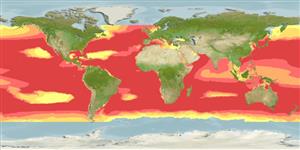>
Stomiiformes (Lightfishes and dragonfishes) >
Sternoptychidae (Marine hatchetfishes) > Sternoptychinae
Etymology: Argyropelecus: Greek, argyros = silvered, silver + Greek, pelekys = axe (Ref. 45335).
Environment: milieu / climate zone / depth range / distribution range
Ecologia
marinhas batipelágico; intervalo de profundidade 0 - 2400 m (Ref. 74511), usually 100 - 700 m (Ref. 28981). Deep-water; 60°N - 56°S
Eastern Atlantic: north of British Isles to South Africa, including western Mediterranean. Western Atlantic: New Jersey, USA to Argentina (Ref. 26340). Northwest Atlantic: Canada (Ref. 5951). Eastern Pacific: throughout the California Current area, seaward of the continental shelf (Ref. 35838). Known from tropical and subtropical waters of all oceans (Ref. 47377). South China Sea (Ref.74511).
Length at first maturity / Tamanho / Peso / Idade
Maturity: Lm ?, range 3 - ? cm
Max length : 5.1 cm TL macho/indeterminado; (Ref. 96016); peso máx. Publicado: 1.42 g (Ref. 128245); Idade máx. registada: 1.00 anos (Ref. 5168)
Descrição breve
Chaves de identificação | Morfologia | Morfometria
Espinhos dorsais (total) : 0; Raios dorsais moles (total) : 8 - 9; Espinhos anais: 0; Raios anais moles: 11 - 12; Vértebras: 36 - 39. Body bright silvery in color; body and trunk with dusky coloration at night (Ref. 4054). Branchiostegal rays: 10 (Ref. 35838).
Oceanic (Ref. 4739) and mesopelagic, mainly at 250-650 m (Ref. 4054). Depth range from 100-700 m (Ref. 4462) and from 460-1082 m in the eastern Ionian Sea (Ref. 56504). Adults make marked vertical migrations (Ref. 4739). Found singly or in small groups (Ref. 4739). An opportunistic feeder at dusk on calanoid copepods, small fishes, etc (Ref. 4739). Sexual dimorphism with regard to body size (Ref. 5168), the males being slightly smaller than the females (Ref. 8966). Oviparous, with planktonic eggs and larvae (Ref. 35838).
Occurs between 200 and 700 m depth during the day, concentrated between 350 and 550 m, and between 100 and 650 m at night, preferring a depth between 150 and 380 m Ref. 47377). Also Ref. 58302.
Spawns more than once per season with egg batches about 50-500 egg/ovary pair, the number increasing with increased animal size (Ref. 4739).
Gon, O., 1990. Sternoptychidae. p. 123-126. In O. Gon and P.C. Heemstra (eds.) Fishes of the Southern Ocean. J.L.B. Smith Institute of Ichthyology, Grahamstown, South Africa. (Ref. 5168)
Categoria na Lista Vermelha da IUCN (Ref. 130435)
Ameaça para o homem
Harmless
Utilização humana
Pescarias: sem interesse
Ferramentas
Relatórios especiais
Descarregue XML
Fontes da internet
Estimates based on models
Preferred temperature (Ref.
123201): 5.5 - 21.3, mean 11.3 °C (based on 2694 cells).
Phylogenetic diversity index (Ref.
82804): PD
50 = 0.5078 [Uniqueness, from 0.5 = low to 2.0 = high].
Bayesian length-weight: a=0.01698 (0.00984 - 0.02932), b=3.11 (2.96 - 3.26), in cm total length, based on LWR estimates for this species & Genus-body shape (Ref.
93245).
Nível Trófico (Ref.
69278): 3.1 ±0.14 se; based on food items.
Resiliência (Ref.
120179): Elevada, tempo mínimo de duplicação da população menor que 15 meses (tm=1; tmax=1).
Fishing Vulnerability (Ref.
59153): Low vulnerability (10 of 100).
Nutrients (Ref.
124155): Calcium = 53 [14, 266] mg/100g; Iron = 0.636 [0.179, 2.130] mg/100g; Protein = 2.42 [0.00, 6.40] %; Omega3 = 0.273 [0.071, 1.024] g/100g; Selenium = 9.22 [2.53, 44.10] μg/100g; VitaminA = 33.7 [3.6, 314.7] μg/100g; Zinc = 0.916 [0.368, 2.357] mg/100g (wet weight);
